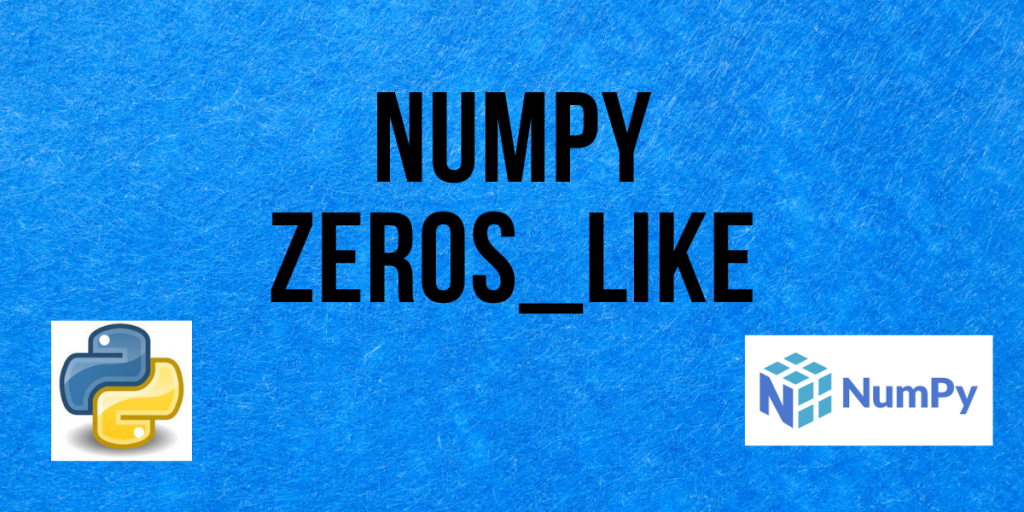In this tutorial, we will be learning about the NumPy zeros_like method and also seeing a lot of examples regarding the same. So let us begin!
Recommended Read: NumPy zeros – A Complete Guide
What is NumPy zeros_like?
The zeros_like method in NumPy is a function that returns an array of zeros having the same shape and size as the given array.
Syntax of zeros_like
numpy.zeros_like(a, dtype=None, order=’K’, subok=True, shape=None)
| Parameter | Description | Required/Optional |
| a (array_like) | An object which defines the shape and data type of the array to be returned. | Required |
| dtype (data type) | The data type of the desired array. Overrides the data type of the result. | Optional |
| order | The desired order in which the multi-dimensional data is to be stored in the memory. It can be row-major (‘C’), column-major (‘F’), ‘A’ means ‘F’ if a is Fortran contiguous, ‘C’ otherwise. ‘K’ implies matching the layout of a as much as possible. | Optional |
| subok (bool) | Determines whether the newly created array will use the sub-class type of a (subok=True) or will be a base class array (subok=False). The default value is True. | Optional |
| shape | The shape of the desired array. Overrides the shape of the result. | Optional |
Returns:
An array with the same shape and data type as the given array.
Examples of Numpy zeros_like function
Let’s now take a look at how the numpy.zeros_like() function works and what is the expected output for different types of inputs.
1-dimensional array using zeros_like
import numpy as np
a = np.arange(10)
print("a =", a)
b = np.zeros_like(a)
print("b =", b)
Output:
a = [0 1 2 3 4 5 6 7 8 9]
b = [0 0 0 0 0 0 0 0 0 0]
2-dimensional array using zeros_like
N x N array
import numpy as np
a = np.arange(10).reshape(2, 5)
print("a =\n", a)
b = np.zeros_like(a)
print("b =\n", b)
Output:
a =
[[0 1 2 3 4]
[5 6 7 8 9]]
b =
[[0 0 0 0 0]
[0 0 0 0 0]]
1 x N array
import numpy as np
a = np.arange(10).reshape(1, 10)
print("a =\n", a)
b = np.zeros_like(a)
print("b =\n", b)
Output:
a =
[[0 1 2 3 4 5 6 7 8 9]]
b =
[[0 0 0 0 0 0 0 0 0 0]]
N x 1 array
import numpy as np
a = np.arange(10).reshape(10, 1)
print("a =\n", a)
b = np.zeros_like(a)
print("b =\n", b)
Output:
a =
[[0]
[1]
[2]
[3]
[4]
[5]
[6]
[7]
[8]
[9]]
b =
[[0]
[0]
[0]
[0]
[0]
[0]
[0]
[0]
[0]
[0]]
1-dimensional float-type array
import numpy as np
a = np.arange(10)
print("a =", a)
b = np.zeros_like(a, dtype=float)
print("b =", b)
Output:
a = [0 1 2 3 4 5 6 7 8 9]
b = [0. 0. 0. 0. 0. 0. 0. 0. 0. 0.]
2-dimensional float-type array
import numpy as np
a = np.arange(10).reshape(2, 5)
print("a =\n", a)
b = np.zeros_like(a, dtype=float)
print("b =\n", b)
Output:
a =
[[0 1 2 3 4]
[5 6 7 8 9]]
b =
[[0. 0. 0. 0. 0.]
[0. 0. 0. 0. 0.]]
Difference between zeros and zeros_like
Note that, in the zeros method we are creating a new array of our desired shape and data type having all the values as 0. But, here, we are directly passing an array or an array-like object to get an array of the same shape and data type. The NumPy zeros_like function takes more time than the NumPy zeros function to produce an array with all 0.
Conclusion
That’s all! In this tutorial, we learned about the Numpy zeros_like method and practiced different types of examples using the same.
